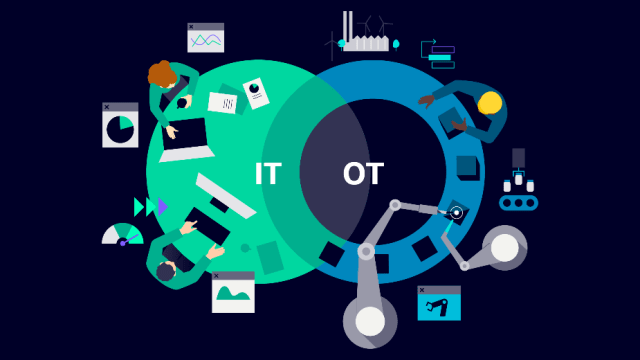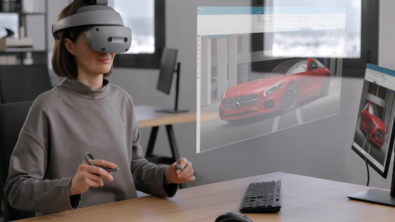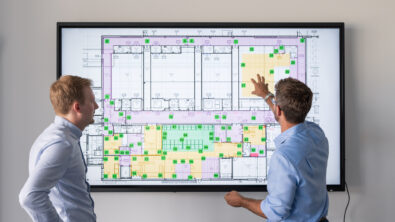Understanding IT/OT convergence: Benefits, challenges, and real-world insights- Ep. 1 Transcript

Chris Pennington: Hi, everyone. I’m your host, Chris Pennington, Global Industry Marketing Lead for Industrial Machinery. On this episode, we’ll cover the topic of IT/OT convergence, including the potential benefits it offers challenges that companies may face, and real-world insights from Siemens very own factory, where they are well into their IT OT integration journey.
We’re joined by our expert, Rahul Garg, Vice President of Industrial Machinery Siemens. His 25-year career includes delivering global software-based solutions for product engineering and manufacturing innovation.
In addition, we’ll be speaking with Peter Zech, Head of Innovation and Digitalization at the Siemens Electrical Motor Factory in Bad Neustadt. Many thanks for joining us today, Peter, to start, could we give, could you give us a brief introduction and explain your role at bad news stat?
Peter Zech: Sure. You mentioned that I’m head of the Department of Innovation and digitalization and we must develop automation and test systems for our own factories. But we are also implementing and operating data driven use cases for our own factories and there we are using IT data and OT data to improve the productivity of our production.
Personally, I am an electrical engineer, and I always had a passion for digitalization and software, and before I really put my focus on digitalization, I had different roles within the organization, PLM and SLM. I have experienced the processes I want to improve now with digitalization from inside, and that helps me understand my internal customers better.
Chris Pennington: Thanks for introduction Peter. Based on your firsthand experience at Bad Neustadt, what motivated you and your team to take on becoming a digital enterprise or a digital factory?
Peter Zech: To give you an insight on that. For us, factory competitiveness and productivity are very important, and the duration was a couple of years ago that we see that the impact of classic productivity measures was declining. We have utilized lean and stuff like that already and it was not an option for us to accept that decline in productivity.
We said what’s next? What is new? Which tools and approaches can help us to remain on the productivity level, or even to add, let’s say further productivity on top of that and there we decided that digitalization and flexible automation is the tool that will help us there and that was the starting point of our journey towards the digital factory.
Rahul Garg: That’s a very compelling reason to go down this journey. That’s very interesting to hear that, Peter, in this transformation or in this effort to become a digital factory and take on this digitalization journey, one of the topics we want to cover with you today is around, IT and OT convergence and IT OT integration.
This whole concept of IT OT convergence is very important. Maybe you can tell us from your point of view, why is this topic of IT OT convergence important in your vision of a digital factory and how did this ITO convergence become a focus topic?
Also within your factory.
Peter Zech: OK, first of all, let me outline what is our vision over there to reflect that the different segments or aspects of the digital twin, of course digital transformation, having the workflows in place that can really realize all the use cases and utilized to technologies, but also the aspect that we would like to become a data driven organization and actually we have learned throughout that journey towards the data driven organization. How important is IT OT integration or IT OT convergence?
If so, as many others, we have started with connecting machines utilizing OT data. But we have many additional use cases that require some IT data.
For example, performance management of value stream or let’s say quality reporting and today since we are for quite a while on that journey, we even see that we have use cases that require the linkage and the correlation of it and OT data that means we have really experienced throughout our journey the importance of that topic. We have also decided this will be our focus topic. We must make sure that we really, really utilize the full potential of all data that we have in the organization.
To put it very simply, the need to have IT OT convergence and IT OT integration was driven by the by the desire to have a data driven organization and given that data was sitting in different systems and IT systems and OT systems which are running the machines you needed a way to bring all of that information together. But the set inside or that was not there from the beginning.
We learned it while we are getting more mature in use cases. Actually, the driver was the request from our production unit means and our colleagues in the production we need more insights. We need to correlate data from IT systems with data from the shop floor. And yes, it was part of the vision we learned throughout our journey and driven by use cases from the shop floor team.
Rahul Garg: That’s very interesting.
Peter Zech: If we were to take a couple of steps back, the need to improve overall productivity and efficiency was the highest.
The measure you’re looking for and as part of that having the ability to have more insightful data was the 2nd requirement that came in and as you were looking at the use cases of making data driven decisions, you found that OK, you need information from multiple systems.
Exactly what you’re sitting in somewhere, sitting in IT systems somewhere, sitting in our systems and those use cases led you all to see how to bring that together.
Chris Pennington: I’m really interested Peter in how you begin this transformation. You know, if we go back to the times when your role didn’t exist, how does a company go about forming an organization to really lead this transformation of IT/OT?
Peter Zech: You need to address 2 topics in parallel and that’s what we did also. We talked about technology and use cases first. We said OK, which use cases we would like to realize with which use case we would like to start, and which capabilities or technologies do we need for that. That was the starting point.
We have a called use case repository where we said OK, we would like to do not only performance management, but we would also like to do management and sustainability as they become more and more important. You know, that was creating the big picture with use cases and technologies.
And the second part is, let’s say you have to empower your organization and not only the team that is going to use the technology and implement the use cases, but also your end users on the shop floor.
They need to learn how to utilize data, how to turn data into productivity, and these are the two aspects and that is how we started in parallel and really taking care of the technology, understanding the use cases that might be beneficial.
Empowering the teams on the shop floor that have to realize the productivity and as we see that we are growing into the organization, we are getting more and more mature and the idea the use cases are also becoming more and more complex and with a higher impact on the productivity.
Rahul Garg: Peter, if you don’t mind, can you give us a couple of examples of these use cases, what did you do? And then maybe explain in a little bit in more detail what is the productivity value or advantages you’ve got you’re looking to achieve with those use cases?
Peter Zech: To give you some examples, we started with our initial use case, and I think that is quite similar to many customers that we also see with partners and the machine performance topic. We have achieved better machine utilization. Actually, we have been able to scrap some of the older machines to save on maintenance costs.
That was the initial very easy use case that where we started with and from that on board. We established the basic connectivity with that and then we have reduced downtime with digital maintenance. We are currently focusing on energy savings, and we are generating transparency. Our energy scouts, which are responsible for energy reduction in the production units in utilizes transparency, defined with additional measures like hibernation, shutdown over the weekend, more efficient components—They have been able to reduce significantly the energy consumption, of our production.
Rahul Garg: Very interesting. You know we are at Realize LIVE this week in Munich, Germany and we had a chance to hear some more customers talking about how they are seeking or they’re achieving value as well by bringing some of these technologies together.
And one of the examples I heard was from Coca Cola about how they are leveraging IT OT convergence to help improve the speed of service in their operations. Because anytime some equipment goes down, it’s a very high cost for them.
And by using IT OT convergence, they can be more proactive and responsive to their service needs, right? And that’s what they were improving their overall productivity for any avoiding any downtime and minimizing the downtime impact.
Peter Zech: Definitely that helps, since what we have learned is the downtime itself is an issue or it’s a waste, but if you then look really into the topic and see how much additional waste you are generating since you have to reschedule transport material from, maybe you have to cancel a shift.
that is really an issue and it’s not only the downtime, it’s downtime, but the impact of the downtime impacts the whole organization.
Rahul Garg: You know, maybe you have to talk to the customer. You have to postpone the delivery stuff like that it’s really an important topic to be aware of when you have and breakdown of a machine to prepare yourself or really to avoid that breakdown.
Chris Pennington: It’s good to hear that you’re getting that positive vibe about digitalization and IT OT convergence while you’re in Munich. And I know typically that’s not the kind of thing that we hear.
We hear a lot of companies have big apprehensions about integrating IT and OT in the factories.
Maybe I could ask you to just touch on some of the concerns we’ve heard in the past about why companies avoid going down this route of it, see convergence and maybe Peter you can share some of the challenges that you’ve experienced yourself during this digitalization journey.
Rahul Garg: You know, Chris, it’s interesting you asked that because in fact that one presentation I was referring to which was done by Coca Cola and because it was presented in this in this open event, I’m I’m referring to them.
They highlighted the biggest reason they were looking at how to improve their IT OT security was quite similar to what Peter highlighted. Number one was improving productivity and performance and number 2 was around cyber security.
They identified that there were many cyber threats that they were experiencing in their plans and by better understanding the whole IT OT integration and better. By Implementing the necessary tools, they were able to control the cybersecurity threats by also improving the networks and by improving the integrations they were able to do a better job of the of the cybersecurity as well.
I think that was that was a quite an interesting view as to how they were able to leverage IT/OT integration to improve cyber security and even the bring in things like improving the flow of information and bringing real time information for closing of issues.
As I mentioned, service servicing of the of the production plan was a was a big gap that they felt and the other one that they that they mentioned also was there their need to close kind of the cultural gaps between different groups of people right the typical IT people were more on the on the on the computer room if you will and the OT people who are more on the shop floor and by having this this focused effort in their plans around IT/OT convergence they were able to bring a lot of the people together and reduce the cultural barriers, if you will, between these organizations and get them to work together in a more focused way, in a more organized way, and it’s helped them quite a bit in that regard. Maybe Peter, if you want to share some thoughts on how you did that.
Peter Zech: First, I can only confirm what Coca-Cola or other customers said. I think this has been challenging as we had also in the past and sometimes still have, if the continuous work on that looking back, I see also to maybe additional challenges. What we have seen is that building an ecosystem that can address or enables more use cases than the initial use case requires significant effort and time. You have to build up competences, you must apply technology, and you need the commitment from the management on the organization that you will not get in return of invest immediately with the first use cases.
It’s a journey but looking back I can really say it’s worth to go on that journey, but you need that commitment. I think that is important. And on the other hand, it’s really it’s not only the administration or the IT and technology implementation teams, we really have to empower all of the colleagues and teams that should work with the data since they are generating the productivity, they have to make something different after you have implemented that use case it’s really to empower these colleagues to give them, let’s say, an insight which capabilities you have, which data you have.
Those are the important though. These are the two topics that users empower them exactly to execute on those decisions and then on that information that they have accessed, exactly showing them what you are capable of. So, to say, also initiating their creativity that they think about where can data help me to make my life or my process even more efficient?
Rahul Garg: Very interesting. At the end of the day, if the user is not leveraging that information, it will not be of much value. Empowering them, as you rightly said, is very important as well.


